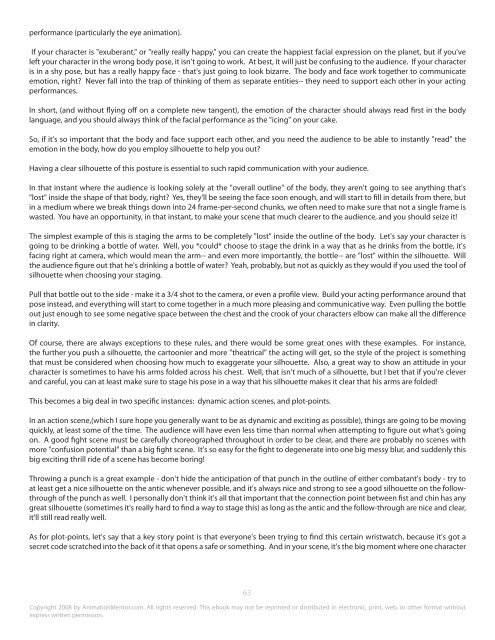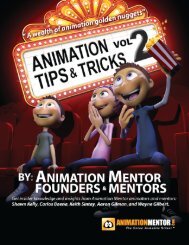Animation Tips & Tricks, Volume I - Animation Mentor
Animation Tips & Tricks, Volume I - Animation Mentor
Animation Tips & Tricks, Volume I - Animation Mentor
You also want an ePaper? Increase the reach of your titles
YUMPU automatically turns print PDFs into web optimized ePapers that Google loves.
performance (particularly the eye animation).If your character is "exuberant," or "really really happy," you can create the happiest facial expression on the planet, but if you'veleft your character in the wrong body pose, it isn't going to work. At best, it will just be confusing to the audience. If your characteris in a shy pose, but has a really happy face - that's just going to look bizarre. The body and face work together to communicateemotion, right? Never fall into the trap of thinking of them as separate entities-- they need to support each other in your actingperformances.In short, (and without flying off on a complete new tangent), the emotion of the character should always read first in the bodylanguage, and you should always think of the facial performance as the "icing" on your cake.So, if it's so important that the body and face support each other, and you need the audience to be able to instantly "read" theemotion in the body, how do you employ silhouette to help you out?Having a clear silhouette of this posture is essential to such rapid communication with your audience.In that instant where the audience is looking solely at the "overall outline" of the body, they aren't going to see anything that's"lost" inside the shape of that body, right? Yes, they'll be seeing the face soon enough, and will start to fill in details from there, butin a medium where we break things down into 24 frame-per-second chunks, we often need to make sure that not a single frame iswasted. You have an opportunity, in that instant, to make your scene that much clearer to the audience, and you should seize it!The simplest example of this is staging the arms to be completely "lost" inside the outline of the body. Let's say your character isgoing to be drinking a bottle of water. Well, you *could* choose to stage the drink in a way that as he drinks from the bottle, it'sfacing right at camera, which would mean the arm-- and even more importantly, the bottle-- are "lost" within the silhouette. Willthe audience figure out that he's drinking a bottle of water? Yeah, probably, but not as quickly as they would if you used the tool ofsilhouette when choosing your staging.Pull that bottle out to the side - make it a 3/4 shot to the camera, or even a profile view. Build your acting performance around thatpose instead, and everything will start to come together in a much more pleasing and communicative way. Even pulling the bottleout just enough to see some negative space between the chest and the crook of your characters elbow can make all the differencein clarity.Of course, there are always exceptions to these rules, and there would be some great ones with these examples. For instance,the further you push a silhouette, the cartoonier and more "theatrical" the acting will get, so the style of the project is somethingthat must be considered when choosing how much to exaggerate your silhouette. Also, a great way to show an attitude in yourcharacter is sometimes to have his arms folded across his chest. Well, that isn't much of a silhouette, but I bet that if you're cleverand careful, you can at least make sure to stage his pose in a way that his silhouette makes it clear that his arms are folded!This becomes a big deal in two specific instances: dynamic action scenes, and plot-points.In an action scene,(which I sure hope you generally want to be as dynamic and exciting as possible), things are going to be movingquickly, at least some of the time. The audience will have even less time than normal when attempting to figure out what's goingon. A good fight scene must be carefully choreographed throughout in order to be clear, and there are probably no scenes withmore "confusion potential" than a big fight scene. It's so easy for the fight to degenerate into one big messy blur, and suddenly thisbig exciting thrill ride of a scene has become boring!Throwing a punch is a great example - don't hide the anticipation of that punch in the outline of either combatant's body - try toat least get a nice silhouette on the antic whenever possible, and it's always nice and strong to see a good silhouette on the followthroughof the punch as well. I personally don't think it's all that important that the connection point between fist and chin has anygreat silhouette (sometimes it's really hard to find a way to stage this) as long as the antic and the follow-through are nice and clear,it'll still read really well.As for plot-points, let's say that a key story point is that everyone's been trying to find this certain wristwatch, because it's got asecret code scratched into the back of it that opens a safe or something. And in your scene, it's the big moment where one character63Copyright 2008 by <strong>Animation</strong><strong>Mentor</strong>.com. All rights reserved. This ebook may not be reprinted or distributed in electronic, print, web, or other format withoutexpress written permission.








